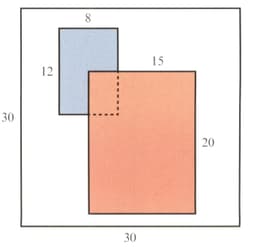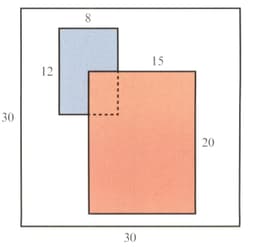The diagram opposite shows a square board with two rectangular cards attached. The by card covers one-quarter of the by card.
A dart is randomly thrown at the board, so that it sticks within its perimeter. Use areas to calculate the probability that the dart pierces:

at least one of the cards


Important Questions on Probability
The diagram opposite shows a square board with two rectangular cards attached. The by card covers one-quarter of the by card.
A dart is randomly thrown at the board, so that it sticks within its perimeter. Use areas to calculate the probability that the dart pierces exactly one of the cards.

Given that and that , find:
Given that and that , find:
Each of tourists was asked which of the countries Angola , Burundi and Cameroon they had visited. Of the group, had visited Angola; had visited Burundi; had visited Cameroon; had visited all three countries; and had visited only one. Of those who had visited Angola, had visited only one other country. Of those who had not visited Angola, had visited Burundi only. All of the tourists had visited at least one of these countries.
Draw a fully labelled Venn diagram to illustrate this information.
Each of tourists was asked which of the countries Angola , Burundi and Cameroon they had visited. Of the group, had visited Angola; had visited Burundi; had visited Cameroon; had visited all three countries; and had visited only one. Of those who had visited Angola, had visited only one other country. Of those who had not visited Angola, had visited Burundi only. All of the tourists had visited at least one of these countries.
Find the number of tourists in set and describe them.
Each of tourists was asked which of the countries Angola , Burundi and Cameroon they had visited. Of the group, had visited Angola; had visited Burundi; had visited Cameroon; had visited all three countries; and had visited only one. Of those who had visited Angola, had visited only one other country. Of those who had not visited Angola, had visited Burundi only. All of the tourists had visited at least one of these countries.
Describe the tourists in set and state how many there are.
Each of tourists was asked which of the countries Angola , Burundi and Cameroon they had visited. Of the group, had visited Angola; had visited Burundi; had visited Cameroon; had visited all three countries; and had visited only one. Of those who had visited Angola, had visited only one other country. Of those who had not visited Angola, had visited Burundi only. All of the tourists had visited at least one of these countries.
Find the probability that a randomly selected tourist from this group had visited at least two of these three countries.
